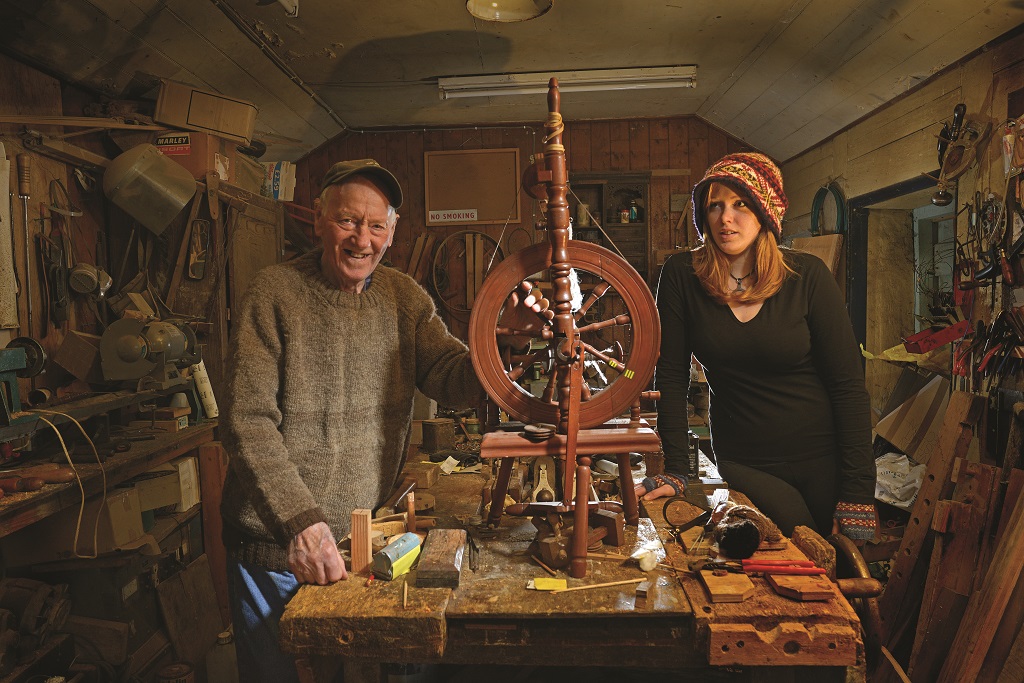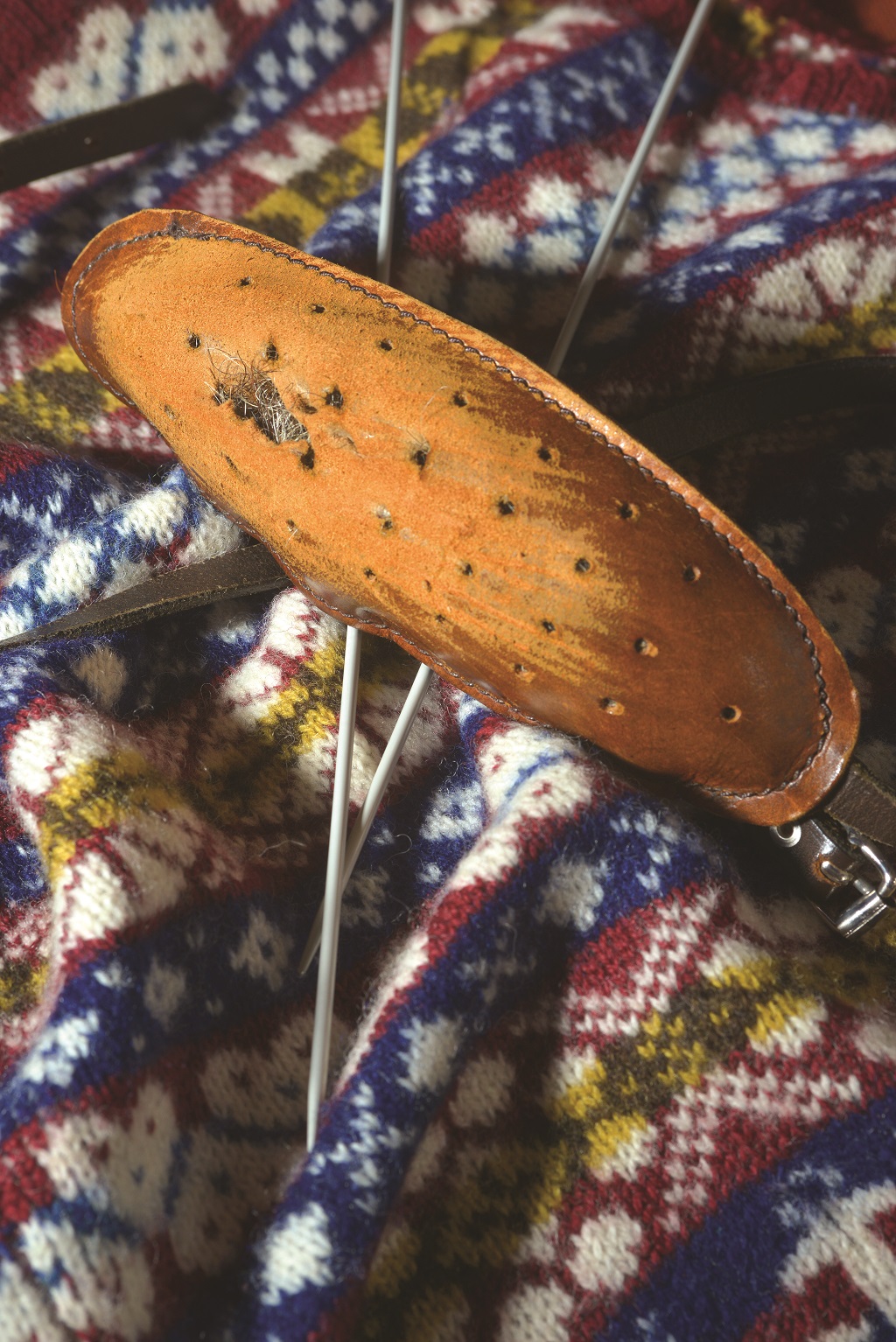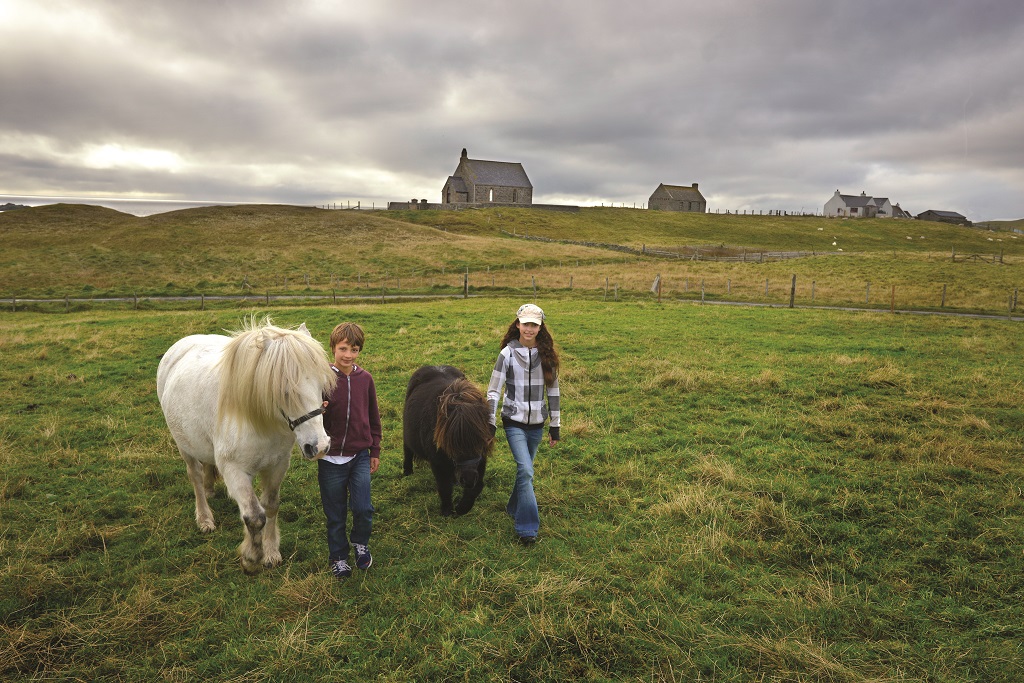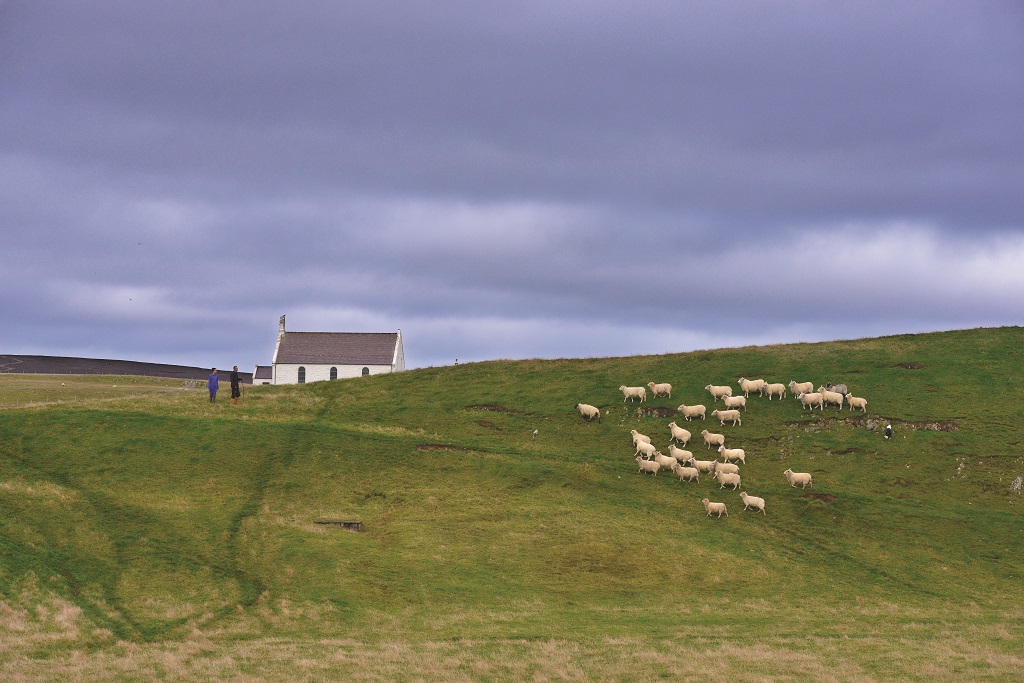The story of how a young couple stopped Fair Isle being cleared of its people, in the process saving a community and an ancient way of life, is an inspiring tale.
In 2013, crofter Stewart Thomson span more than six miles of Shetland wool on his hand-crafted spinning wheel. That’s none-too-shabby considering that the island on which the craggy 89-year-old lives, which is perched in raging seas halfway between the Orkney and Shetland islands, is just three miles long.
Fair Isle knitwear, with its distinctive geometric patterns, is famous the world over. For centuries the islanders exported this wonderfully lightweight, warm, durable garment by trading with passing ships as they bartered their home-made textiles for goods they could not make themselves.
Today, the craft’s survival on the island is due in large part to Thomson, who gave up his career as a lighthouse keeper to return with his young family in 1957 to an island under serious threat of evacuation.
His wife Annie has deep roots here too, her crofting family, the Wilsons, having a history stretching back to 1690. ‘When we came back to Fair Isle we took over this house which needed to be reconditioned, so up in the loft I found an old spinning wheel and I took it down and fixed it up for somebody who wanted a spinning wheel,’ said Stewart.

Stewart Thomson with his great granddaughter, Alice Best (Photo: Angus Blackburn)
‘So I started from there, repairing and making spinning wheels. I’ve made 115 now, and they are all over the world.’
His daughter Anne Sinclair also lives on the island and understands the significance of her family’s arrival. ‘My father came to the island at a crucial time,’ she says.
‘The island was about to turn into the next St Kilda, which was one of the reasons dad left the lighthouse service and came back. They said that if young families did not come back to Fair Isle then everyone would have to leave. My mum was amazing: she left a house with electricity, hot water and a room for everyone for a house with no electricity, no running water and three children to a bed.’
Dotted around Stewart’s house is an array of spinning wheels he has made over the years. ‘There is one packed up ready to go to Canada next week and my great-great-granddaughter helped me make that one,’ he says, pointing to one in the corner. ‘The dark one there is made from a piece of wood I found on the beach, from a mahogany tree, a piece of framework or something. I took it apart and made a wheel from it.’
Stewart’s description of what passes for a beach would not meet most people’s definition. Sheer cliffs rise up over 200 metres on the westerly side of the island, with the wood collected from a few precarious stretches of coastline. The islanders are well used to a life of touch and go, but it takes Stewart 200 hours to make a spinning wheel so its final destination matters to him. ‘I only make a wheel if they are going to spin on it,’ he says. ‘It’s not for decoration. I find out very carefully if they are going to spin on it or not. There is too much work that goes into making the wheel for it to sit idle.’
Stewart’s wife Annie has no jumpers of her own. ‘I didn’t knit anything for myself,’ she says. ‘People could not afford to knit for themselves. I wore mostly what my sisters had grown out of. They had to try and sell everything; they got very little for it.’

A traditional knitting belt (Photo: Angus Blackburn)
Anne, who worked as a school teacher in Shetland and is also an accomplished knitter, now takes a keen interest in running the island’s small museum. ‘You will fi nd that certain things are pleasing to the eye, no matter what culture you belong to, but if you’re knitting and weaving patterns on a grid there are only certain directions you can go in, so you get very close connections with knitting within cultures,’ she says.
‘What is different about Fair Isle designs is what I call the oxo patterns. You get that very strongly in the old Fair Isle knitting and you also get it in the knitting of the Netherlands where the construction, dyes and patterns used are exactly the same. In the Netherlands they are kind enough to say that it started here, but we will never know.’
Anne shows me one of the exhibits. ‘The first piece of knitting we have which we are sure was knitted on Fair Isle was given to us by the National Museums of Scotland in 1857,’ she says. ‘We don’t know when it was knitted but in the 1760’s somebody sailed past Fair Isle and she talks about people rowing out to sell their knitwear. She called it “the softest coarse cloth I’ve ever seen”, which I think is a wonderful phrase.’
Her keen interest in the island’s history has given Anne an authoritative voice, and she has no qualms about dispelling a few myths. ‘The famous jumper that Edward VIII , The Prince of Wales wore with knickers, spectator golf shoes and Argyll socks, was not made on Fair Isle,’ she says. ‘That jumper was actually made in Shetland because they had copied the patterns, which they had every right to, having set up a trademark with ourselves. The Duke of Edinburgh has a jumper that was made here though – it was ordered by the Palace by letter and I have a copy of his thank you letter too.’

Hollie Shaw’s children, Ythan and Raven (Photo: Angus Blackburn)
Despite the royal connections, Fair Isle’s knitters have never become rich from their efforts. ‘My Auntie Molly was charging £4 for a man’s jumper in the 1970s, and you’ve no idea the problems I had getting her to put up prices,’ says Anne.
‘In those days there was little value put on Fair Isle knitting in Shetand as I found when I visited a lady there who was from Fair Isle. She was selling to one of the Shetland firms and I went down with her one day with a pair of really nicely made Fair Isle gloves, and the man in the shop gave her five shillings then turned round and put them in the shop window with a ticket for nineteen and six on it, while we were still in the shop. I’m still appalled at that, but that was the attitude.’
Today things are changing for the better. The visit of the Tall Ships Regatta in 2011 galvanised the community into re-enacting an ancient tradition; getting the women together to knit several Fair Isle fishermen’s keps (woollen hats), and sending the men out in yoals (rowing boats) to meet and barter with the sailing ships’ crews. It was a huge success, invigorating the community.
With the ubiquitous use of Fair Isle knitwear as a trading term, I asked Anne how she would define the genuine article. ‘I would classify an authentic Fair Isle jumper as one which has been made here by hand and that includes having no seams in the garment, which means that you get a finer edge to the jumper,’ she says. ‘As far as the pattern is concerned, authenticity is really difficult because it has become such a widespread thing. Certainly no more than two colours in one row. Generally speaking there should be two small patterns to one big one. On an entirely personal level I don’t think it can be Fair Isle if it’s pink!’
If Stewart and Annie Thomson saved Fair Isle from clearance and then revived its knitwear by making spinning wheels, spinning the wool and continuing to produce the garments, their experience has also helped other islanders. Hollie Shaw and Catriona Thomson, two of Fair Isle’s 68-strong population who both originally arrived on the island to work at Fair Isle Bird Observatory, are the island’s other two knitters and have been the grateful beneficiaries of the Thomsons’ wisdom.

Gathering sheep on the Fair Isle (Photo: Angus Blackburn)
‘Having left the bird observatory my husband and I needed to find a way to supplement our income from the croft,’ says Holly. ‘Catriona, who picked up her skills from Annie and has been knitting for several decades, has become my mentor in every way. I wouldn’t have been doing knitting if it wasn’t for her. We spend half the winter knitting ordered jumpers and the other half knitting stock, selling the vast majority to people who are visiting the island, even if it’s just hats to people who arrive on cruise ships. We don’t advertise because demand is so high and we have to be careful what we commit to.’
Stewart and Annie will celebrated their seventieth wedding anniversary in February 2014, and times have certainly moved on from the days when they set up home on Fair Isle. The islanders have power generated until 11pm each evening by wind turbines and diesel generators. Their homes are also connected to the internet, not that the islanders have ever felt alone. ‘Looking at a map you might think we were entirely isolated, but in fact we are in the middle of a shipping route,’ laughs Anne.
Later Stewart showed me his workshop. In the corner amongst his tools was an old lathe which he once used for turning the wood to make spinning wheels. ‘There was no electricity then. I had to power it with my foot, but later I put a wee electric motor on it because times have changed.’
On Fair Isle, however, the more things change the more they stay the same. When Stewart and Annie saved the island in 1957 they preserved a way of life that has been enthusiastically embraced by Anne, Hollie, Catriona and the remaining islanders. For that, history will be very kind to them.
(This feature was originally published in 2019)
For more info visit www.fairisle.org.uk
TAGS

